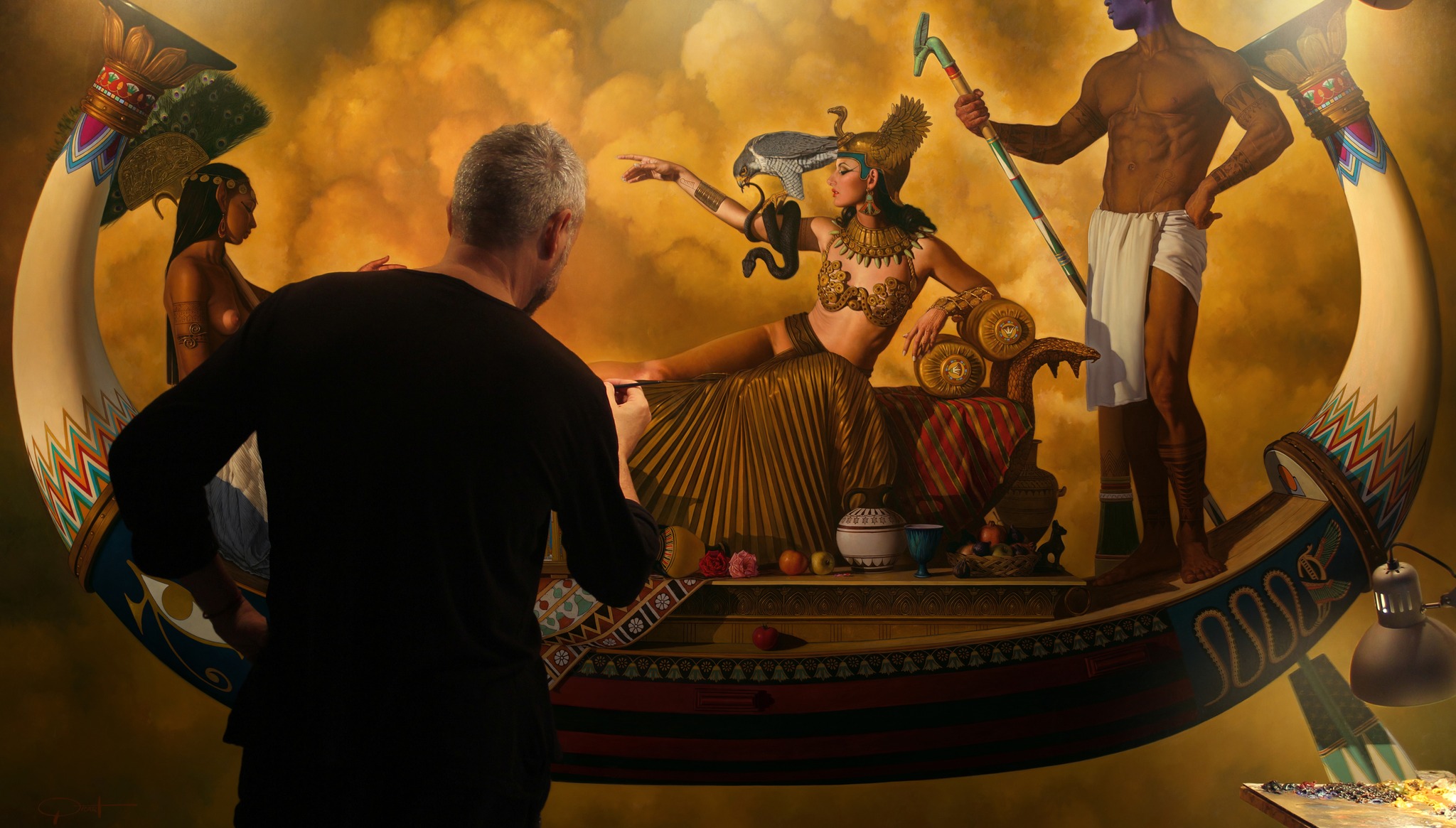THE
URN
AN ESSAY ON CHANGE CLOAKED IN GOLDEN BEAUTY
An explosion of gilded loveliness takes us on a majestic trip. Amid the golden glow of the sun, the vessel, cargo, and passengers gently make their way to a solemn destination. The painterly execution with a flawless treatment of illumination adds to the mystical atmosphere of the scene. The textures of the deeply symbolic objects, precious fabrics, firm skins, and the pushing clouds, leave us gazing from one perfect detail to the next. Under the rich detailed tapestry of these interlocking layers, there lies an essay on Change.
The Urn is an allegory of those big changes that we all go through in our lives, and the forces that are involved. They are always the same, whether a house move, the loss of a loved one, or a political revolution. Some may rely on us, such as Confusion, Will and Hope, while others are fully arbitrary, such as Fortune and Adversity. A journey from life to the afterlife, is the ultimate big change that we can think of, and the characteristics of some Egyptian deities made them suitable to embody these forces mentioned.
Cleopatra VII Philopator floats mid-air on her journey to the great beyond, and presents as the centerpiece of this pictorial universe. But rather than being an accurate depiction of the Queen, she is a symbol. The Egyptian Queen represents ourselves, the people, either individually or collectively. Cleopatra raises her arm to reach the new life from the goddess Bastet; this is, to reach our own goals. The model is none other than the painter’s daughter, Allegra. Incidentally, Cleopatra’s name means “The Glory of the Father.”
On the left, Bastet, the protective goddess of the home, offers Cleopatra a sistula containing milk, while holding a fan. Because the air they move, in Ancient Egypt fans were related to breath. Therefore, Bastet offers the new life to the Queen. Allegorically, she hands to us whatever we hope to achieve in every big change in life.
In the painting, the snake that killed Cleopatra embodies Apep, the evilish deity that opposes to Light and Truth. Coiled around her arm, it intends to prevent the Queen from achieving her end. Apep symbolizes Adversity, and by extension, all these things that hinder making positive changes in life.
Fighting the serpent we see Cleopatra’s peregrine, who is no other but Ra himself. The falcon represents the good Fortune we all need to beat adversity.
In times of change, Confusion runs our lives. On the right and next to the Queen, the god Seth is at the helm of the barque: he is the god of Chaos, Confusion, Storm and Earthquakes. He is watching a sacred ibis, which guides him in the right direction. It is Toth, the god of Wisdom, Knowledge and Painting.
But not only royals and powerful deities play a role in this static opera. Adorned with a cornucopia of carefully placed fruits, statuettes and goblets all with their own, deeply specific meaning, this piece could easily render many thoughts among viewers who recognize these objects in all their symbolism, no matter how small and humble they are.
On the center of the composition, we notice a lonely tomato. Tomato was unknown in Ancient Egypt and it does not belong here. Picart’s purpose to paint one that prominently was double. At first, as some kind of red flag to warn viewers that his painting never intended to be an accurate depiction of Ancient Egypt, but an allegorical artwork instead. Secondly, and for that same reason, it symbolizes the Fake News that prevent us from true information, which is required to make positive changes, whether as individual, or as society.
The Urn
A TITLE FILLED WITH SIGNIFICANCE
Albeit, the most relevant object to the author is the urn. In Catalan and Spanish, the word “urna” (urn) has got three different meanings: a funeral urn, a ballot box, and a container for storing valuable things. The first two are related to major changes in the artist’s life: the death of his mother, and the events of the Catalan self-determination referendum in October 2017. The box under Anubis has got the third meaning of the word, as it treasured relics. Hence the title of the painting.
In the words of the artist himself, “Life is change, and every change an opportunity for growth. In turbulent times, may the ancient god of Wisdom and Painting Toth guide you in the right direction.”
